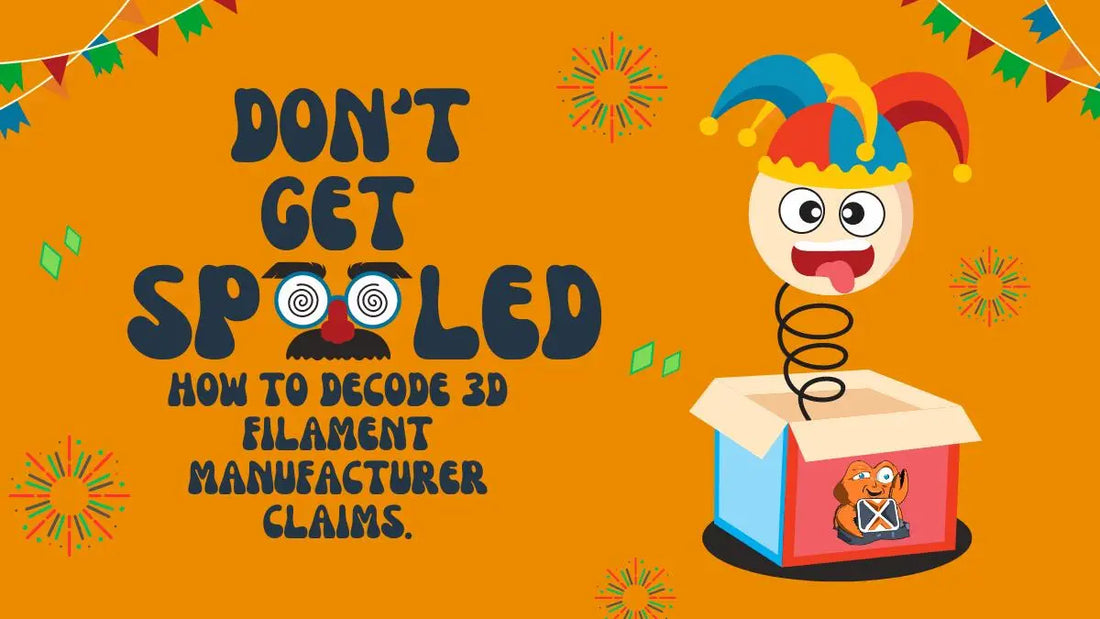
Don't Get Spooled! How to Decode 3D Filament Manufacturer Claims.
Josh BonninShare
The vibrant world of 3D printing offers endless possibilities for creators.
But with that freedom comes a crucial step: choosing the right filament. With a plethora of manufacturers and technical jargon, deciphering what you're actually getting can feel like deciphering ancient scrolls. Fear not, this guide will equip you with the knowledge to navigate the 3D filament landscape with confidence. Finding a true US 3D filament manufacturer may take some sleuthing, but will be worth the effort if you prefer not to buy a material made in China.
Know Your Material Needs:
Before diving into manufacturer specifics, identify your project's requirements. Are you printing a decorative figurine that prioritizes aesthetics? Or a functional tool that needs strength and heat resistance? Understanding your needs will guide you towards the right material properties. Popular options include PLA (easy to print, good for beginners), ASA, ABS, or PETG (stronger, but requires more care), TPE or TPU (highly durable and flexible), and Nylon (highly durable, high heat tolerance).
Manufacturer Transparency is Key:
A reputable manufacturer prioritizes transparency. The unfortunate and ugly truth of 3D printing filament is that there is no regulating body overseeing manufacturers and what they call the products they produce. You can enter PLA in Google and find pages of results, but all PLAs are not equal. Inexpensive filament is often made from inexpensive materials, often recycled materials. What some manufacturers would consider + or Prime may be a quality manufacturer's base PLA. We would proudly put our PLA up against any imported + or Prime versions. Here's what to look for on their websites or product descriptions:
- Material Breakdown: Does the description clearly state the base material? Is it a virgin resin or a recycled resin that may be unclean?
- Technical Specifications: Look for a datasheet with details like diameter tolerance, tensile strength, and heat deflection temperature. These metrics provide a quantitative understanding of the filament's capabilities.
- Printing Recommendations: Does the manufacturer offer recommended printing temperatures, bed temperatures, and printing speeds? This basic information should always be provided and it helps you dial in your printer settings for optimal results.
- Nozzle Temperatures: The long polymer chains of plastic become shorter each time they are melted, this reduces the melt temp and strength.
- Look for "Natural" color option: Colorant makes filament pretty but it also can disguise the purity of the base material. When a filament brand does not offer their products in a Natural color they are likely trying to hide the fact that they aren't using a pure base raw material. Even if you want a specific color get in the habit of checking to see if a Natural option is offered.
Manufacturer vs Reseller Brands:
If you search for US filament brands, you will see many listed, but not all are equal. Many of these company sell what is called "white label" or "private label" products. That is where they often contract with an overseas manufacturer to make spools with their label and simply resell it. While doing research on brands, look through the website. Do they show their production equipment? If you look at their facility on google maps, does it look large enough to house production?
Reviews and Community Insights:
Don't underestimate the power of the maker community! Online forums, review platforms, and social media groups are treasure troves of user experiences. Look for reviews of specific filaments from the manufacturer you're considering. These can reveal real-world performance and potential issues not always highlighted in official descriptions.
Sample Spools and Testing:
Many manufacturers offer sample filament. This allows you to experiment with the filament firsthand and see how it performs on your specific printer. Consider this a small investment that can save you from frustration and wasted filament down the line. To receive a free sample of any of our filament, simple send us an email or add a note to your order to let us know what you'd like to try.
Beyond the Basics:
As you gain experience, you might delve into more specialized features. Some manufacturers offer filaments with unique properties like improved flexibility, conductivity, or even glow-in-the-dark capabilities. Look for manufacturers that cater to these specific needs and provide clear information about these functionalities.
Remember: When in doubt, reach out! A quality filament manufacturer will have excellent customer service and should answer and questions. At Coex 3D we love fielding these questions and will be happy to guide you towards the perfect filament for your project.
By following these tips, you'll transform from a confused consumer to a filament-savvy maker, ready to bring your 3D printing creations to life!

